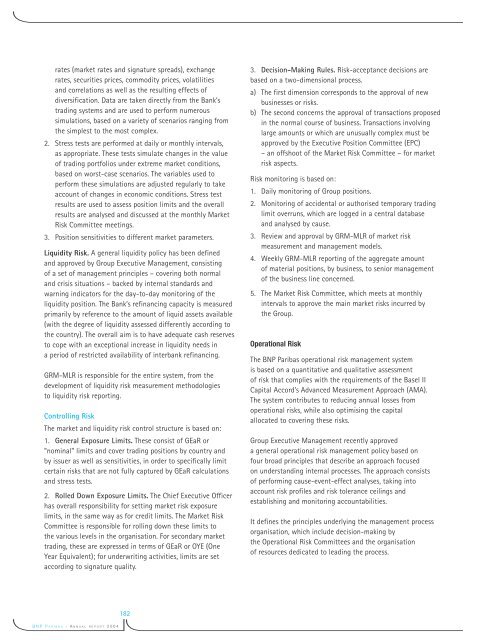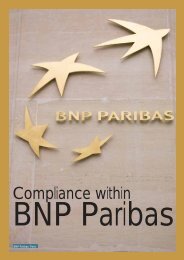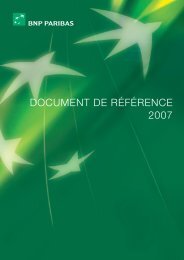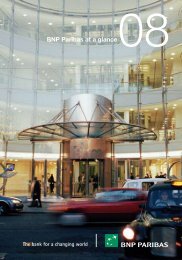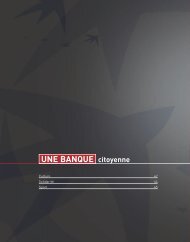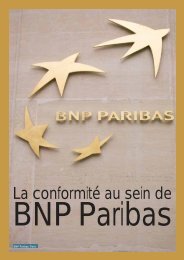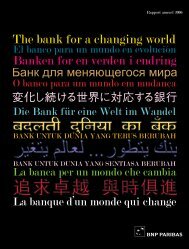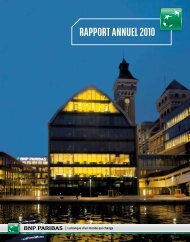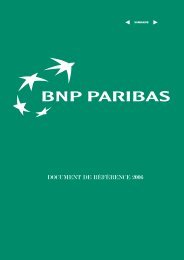La banque d'un monde qui change 2004 - BNP Paribas
La banque d'un monde qui change 2004 - BNP Paribas
La banque d'un monde qui change 2004 - BNP Paribas
You also want an ePaper? Increase the reach of your titles
YUMPU automatically turns print PDFs into web optimized ePapers that Google loves.
ates (market rates and signature spreads), ex<strong>change</strong>rates, securities prices, commodity prices, volatilitiesand correlations as well as the resulting effects ofdiversification. Data are taken directly from the Bank’strading systems and are used to perform numeroussimulations, based on a variety of scenarios ranging fromthe simplest to the most complex.2. Stress tests are performed at daily or monthly intervals,as appropriate. These tests simulate <strong>change</strong>s in the valueof trading portfolios under extreme market conditions,based on worst-case scenarios. The variables used toperform these simulations are adjusted regularly to takeaccount of <strong>change</strong>s in economic conditions. Stress testresults are used to assess position limits and the overallresults are analysed and discussed at the monthly MarketRisk Committee meetings.3. Position sensitivities to different market parameters.Li<strong>qui</strong>dity Risk. A general li<strong>qui</strong>dity policy has been definedand approved by Group Executive Management, consistingof a set of management principles – covering both normaland crisis situations – backed by internal standards andwarning indicators for the day-to-day monitoring of theli<strong>qui</strong>dity position. The Bank’s refinancing capacity is measuredprimarily by reference to the amount of li<strong>qui</strong>d assets available(with the degree of li<strong>qui</strong>dity assessed differently according tothe country). The overall aim is to have adequate cash reservesto cope with an exceptional increase in li<strong>qui</strong>dity needs ina period of restricted availability of interbank refinancing.GRM-MLR is responsible for the entire system, from thedevelopment of li<strong>qui</strong>dity risk measurement methodologiesto li<strong>qui</strong>dity risk reporting.Controlling RiskThe market and li<strong>qui</strong>dity risk control structure is based on:1. General Exposure Limits. These consist of GEaR or“nominal” limits and cover trading positions by country andby issuer as well as sensitivities, in order to specifically limitcertain risks that are not fully captured by GEaR calculationsand stress tests.2. Rolled Down Exposure Limits. The Chief Executive Officerhas overall responsibility for setting market risk exposurelimits, in the same way as for credit limits. The Market RiskCommittee is responsible for rolling down these limits tothe various levels in the organisation. For secondary markettrading, these are expressed in terms of GEaR or OYE (OneYear E<strong>qui</strong>valent); for underwriting activities, limits are setaccording to signature quality.3. Decision-Making Rules. Risk-acceptance decisions arebased on a two-dimensional process.a) The first dimension corresponds to the approval of newbusinesses or risks.b) The second concerns the approval of transactions proposedin the normal course of business. Transactions involvinglarge amounts or which are unusually complex must beapproved by the Executive Position Committee (EPC)– an offshoot of the Market Risk Committee – for marketrisk aspects.Risk monitoring is based on:1. Daily monitoring of Group positions.2. Monitoring of accidental or authorised temporary tradinglimit overruns, which are logged in a central databaseand analysed by cause.3. Review and approval by GRM-MLR of market riskmeasurement and management models.4. Weekly GRM-MLR reporting of the aggregate amountof material positions, by business, to senior managementof the business line concerned.5. The Market Risk Committee, which meets at monthlyintervals to approve the main market risks incurred bythe Group.Operational RiskThe <strong>BNP</strong> <strong>Paribas</strong> operational risk management systemis based on a quantitative and qualitative assessmentof risk that complies with the re<strong>qui</strong>rements of the Basel IICapital Accord’s Advanced Measurement Approach (AMA).The system contributes to reducing annual losses fromoperational risks, while also optimising the capitalallocated to covering these risks.Group Executive Management recently approveda general operational risk management policy based onfour broad principles that describe an approach focusedon understanding internal processes. The approach consistsof performing cause-event-effect analyses, taking intoaccount risk profiles and risk tolerance ceilings andestablishing and monitoring accountabilities.It defines the principles underlying the management processorganisation, which include decision-making bythe Operational Risk Committees and the organisationof resources dedicated to leading the process.182<strong>BNP</strong> PARIBAS - ANNUAL REPORT <strong>2004</strong>


